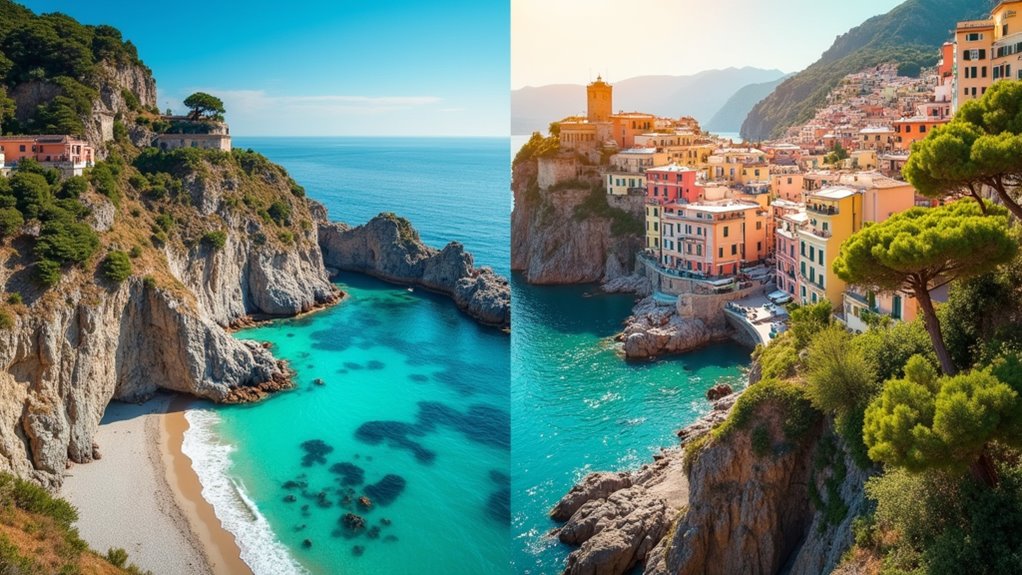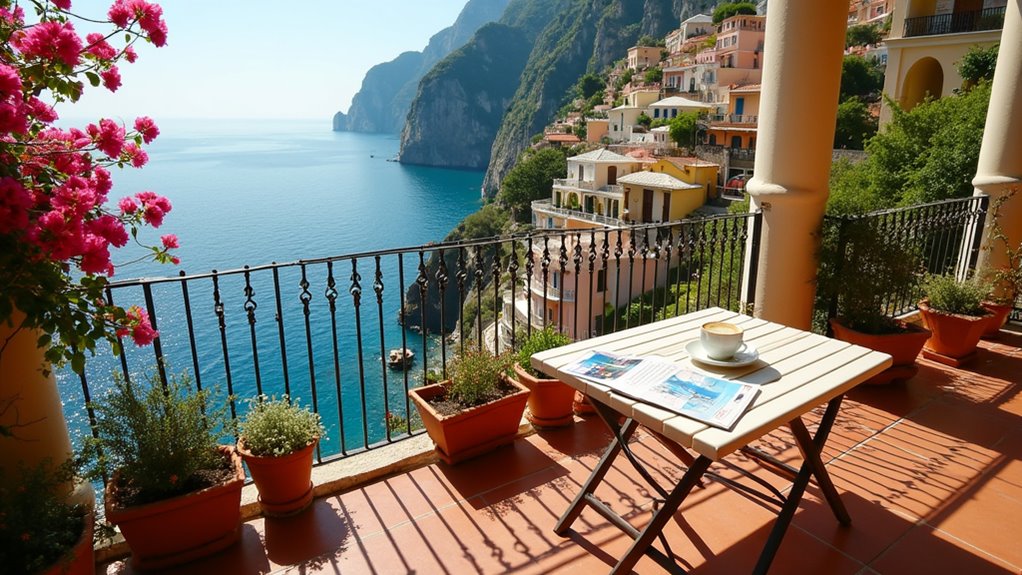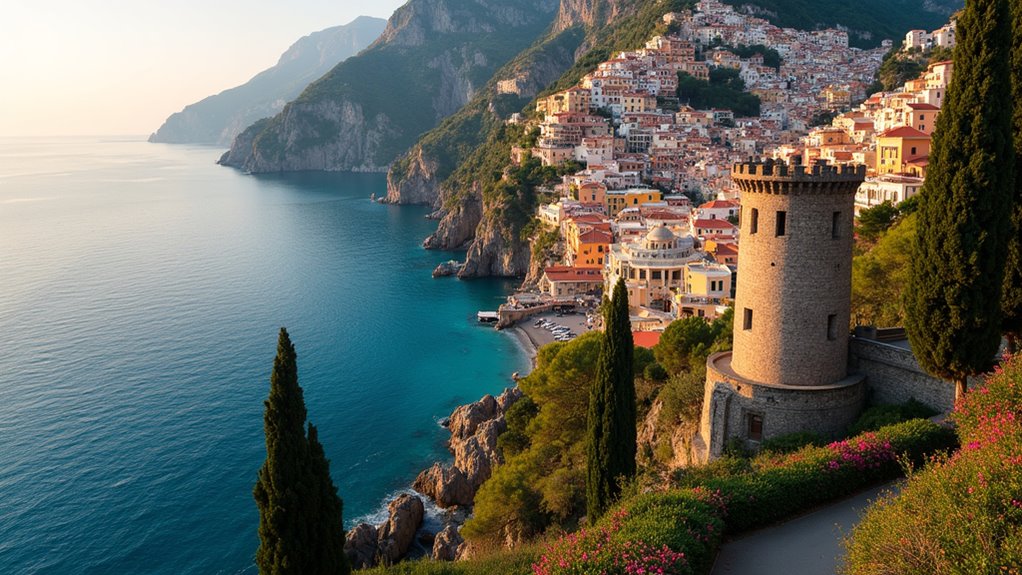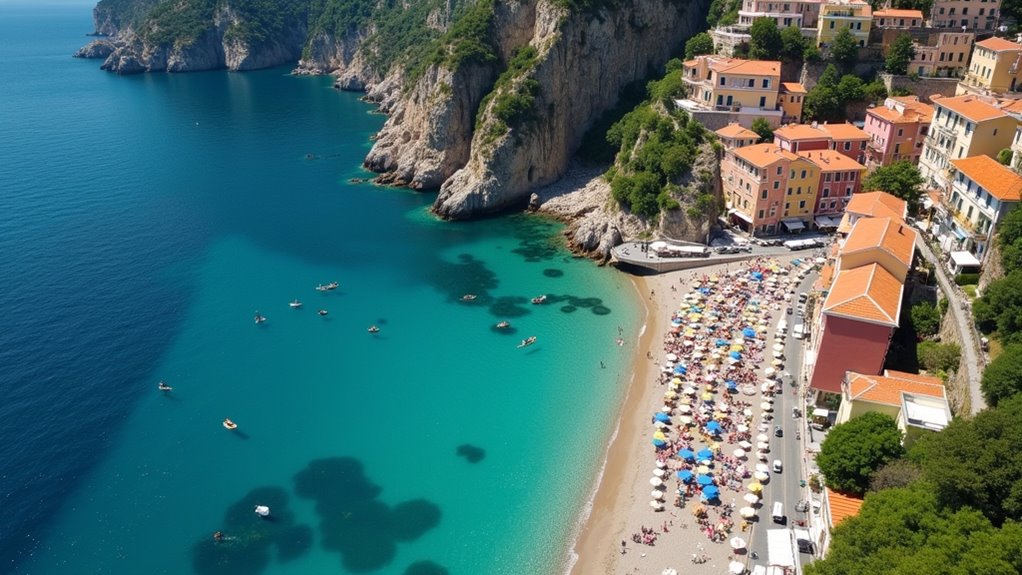Physical Address
304 North Cardinal St.
Dorchester Center, MA 02124
Physical Address
304 North Cardinal St.
Dorchester Center, MA 02124

Paradise beckons from both Italian shores, but which destination matches your vacation dreams: rugged Sardinia or glamorous Amalfi?
Sardinia offers pristine beaches, archaeological wonders, and requires a car rental with more affordable stays. The Amalfi Coast features dramatic cliffs, walkable villages, and better public transport, though at higher prices. Choose Sardinia for family-friendly beaches and outdoor adventures, or Amalfi for romantic cliff-top dining and historical immersion. Your ideal Italian getaway depends on whether you value spacious natural beauty or compact cultural charm. Our complete comparison reveals all the decision factors.

When comparing Sardinia and the Amalfi Coast, you’re looking at two fundamentally different geographical experiences. Sardinia offers the expansive freedom of the Mediterranean’s second-largest island with 1,849 km of diverse coastline. You’ll find rocky cliffs, wide bays, and pristine beaches surrounded by turquoise waters. This makes Sardinia especially ideal for families seeking kid-friendly beaches with sandy areas perfect for children to enjoy.
The Amalfi Coast presents a more concentrated beauty – a dramatic stretch along the Sorrentine Peninsula featuring steep cliffs and deep fjords. While Sardinia spans between 38° and 41° north latitude with varied landscapes including mountains and forests, Amalfi delivers vertical drama with towns perched precariously on cliffside terraces. Both destinations are known for their safety standards and welcoming atmosphere for international visitors.
Your choice comes down to preference: Sardinia’s island vastness and exploration potential versus Amalfi’s compact, vertical coastal experience where everything clings dramatically to the Tyrrhenian Sea edge.
Getting to and around these Italian destinations presents distinct logistical challenges that considerably impact your vacation planning. Sardinia offers three international airports (Alghero, Olbia, and Cagliari), while Amalfi Coast travelers must fly into Naples and arrange transfers to coastal towns.
For mobility, Sardinia requires either a rental car or reliance on limited public transport and ferry services between coastal points. The Amalfi Coast’s public transport is more frequent, but narrow, winding roads make driving stressful. When traveling between locations, consider that Italian high-speed trains provide efficient connections between major cities on the mainland, though they won’t reach island destinations like Sardinia.
Consider accessibility needs carefully—Amalfi’s charming cobblestone streets and steps create barriers for wheelchairs, while some beaches offer amphibious chairs. The Amalfi Coast villages are predominantly pedestrian with limited car access, requiring parking and walking afterward.
Both regions provide private transfers and specialized tour operators with adapted vehicles for those with mobility concerns. Check accommodation accessibility features in advance, as historic buildings may lack modern accessibility standards.

Choosing where to stay in Italy’s premier coastal destinations often represents the most significant portion of your travel budget. Both regions offer distinct accommodation styles across various price points.
In Sardinia, expect to find luxury resorts like Hotel Pitrizza with infinity pools and nuraghe-inspired architecture, particularly in Costa Smeralda. The recently renovated Cala di Volpe hotel showcases vibrant local design with handcrafted furniture throughout the property. Budget-friendly options start at $150 per night, while luxury rates exceed $500.
The Amalfi Coast features iconic properties like Il San Pietro di Positano with private beaches and Le Sirenuse with its Michelin-starred restaurant. Family-run options like Hotel Bristol provide authentic experiences at mid-range prices ($250-$500). For those visiting the region’s port cities like Trieste, many accommodations offer breakfast cafés within walking distance.
Your choice ultimately depends on crowd tolerance (Amalfi is busier), budget constraints (Sardinia offers more affordable options), and preferred amenities (private beaches versus cultural vibrancy).
Beyond your accommodation choice lies the actual reason most travelers flock to these Mediterranean havens: the beaches.
Sardinia offers diversity with remote coves like Cala Goloritzé requiring hikes, plus Caribbean-like waters in Golfo di Orosei. You’ll find pink sands at Isola Budelli and family-friendly shallow waters at La Pelosa. The island’s status as a Mediterranean gem makes it particularly attractive for those seeking pristine natural landscapes.
The Amalfi Coast presents a different experience with smaller, often crowded beaches framed by dramatic cliffs. Most are pebbled rather than sandy, with deeper waters perfect for snorkeling.
Beaches like Atrani are walkable from towns, but parking is limited at popular spots like Positano. Despite its beauty, travelers should be aware that some isolated beaches in Italy can be unexpectedly dangerous due to strong currents and limited lifeguard services.
Sardinia’s beaches focus on natural preservation with fewer amenities, while Amalfi offers upscale beachfront dining options.
For seclusion, Sardinia wins; for lively atmosphere, choose Amalfi.

While beaches draw most travelers to these Mediterranean destinations, both Sardinia and the Amalfi Coast offer remarkable cultural experiences that shouldn’t be overlooked.
Sardinia boasts prehistoric treasures like Su Nuraxi di Barumini, a UNESCO site showcasing Bronze Age architecture, and the mysterious Giants’ Tombs. For cave enthusiasts, Grotto di Nettuno and Domus de Janas provide glimpses into ancient island life. Food enthusiasts will also appreciate the unique foodie heavens that dot the island’s landscape.
The Amalfi Coast counters with Roman history at nearby Pompeii and Herculaneum, plus Byzantine influences at Amalfi Cathedral. Ravello’s elegant villas host cultural events with spectacular views.
If ancient civilizations fascinate you, choose Sardinia for its unique Nuragic culture. Visitors consistently award Nuraghe Santu Antine 4.6/5 bubbles based on hundreds of reviews praising the well-preserved Bronze Age site. For medieval and Roman history with Renaissance artistic flair, the Amalfi Coast delivers.
Both destinations offer museums housing significant artifacts that tell their distinctive stories.
Food plays a central role in the distinct identities of Sardinia and the Amalfi Coast, with each region’s cuisine reflecting its unique geography and cultural heritage.
The culinary soul of Italy reveals itself through regional dishes that tell stories of land, sea and centuries of tradition.
In Sardinia, you’ll enjoy hearty dishes like porcheddu (suckling pig) and culurgiones (potato-cheese ravioli). The island’s cuisine features strong flavors from pecorino cheese and bread varieties like pane carasau. Seafood options include bottarga-topped pasta and fregula with shellfish. Wine enthusiasts can experience the unique Akenta sparkling wine that undergoes underwater aging process for six months at 100 feet below sea level.
The Amalfi Coast offers lighter Mediterranean fare centered around fresh seafood and citrus. Try spaghetti alle vongole (clam pasta), authentic Neapolitan pizza, and eggplant parmigiana. Lemons feature prominently in dishes and the famous limoncello liqueur. These represent some of Italy’s iconic dishes that have become beloved worldwide for their authentic flavors and traditional preparation methods.
While Sardinian cooking shows complex cultural influences with elaborate preparations, Amalfi’s cuisine emphasizes simplicity with fresh ingredients letting natural flavors shine.

Tourism patterns in Sardinia and the Amalfi Coast follow predictable seasonal rhythms that you’ll need to navigate carefully. July and August bring peak crowds and prices, with Amalfi experiencing more congestion than Sardinia. The Amalfi Coast becomes a complete mess in August, with frustrated travelers struggling to find restaurant reservations and move through narrow streets. Both regions strain under summer tourism pressure, affecting roads and local infrastructure. If you’re considering alternative destinations, Capri Island offers stunning coastal views but faces similar crowding issues during peak season.
For a better experience and lower costs:
Supporting local businesses directly puts more money into community hands while choosing shoulder seasons reduces your environmental impact and saves your budget.
Deciding between Sardinia and the Amalfi Coast ultimately comes down to what you value most in your Italian getaway.
Italy presents not two options, but two distinct visions of Mediterranean bliss awaiting your choice.
For families and outdoor enthusiasts, Sardinia wins with diverse activities and superior beaches. Its varied accommodation options fit multiple budgets, though car rental costs are unavoidable.
The Amalfi Coast suits couples and history buffs who prefer car-free travel. Its walkable towns connected by ferries make transportation simple, despite premium pricing for hotels and dining. Keep in mind that ferries may be weather dependent in late October, sometimes being canceled due to high seas or winds.
Consider your priorities: Sardinia offers 1,849km of stunning coastline, adventure sports, and Nuragic ruins. Meanwhile, the Amalfi Coast provides easier access to cultural sites, pedestrian-friendly villages, and proximity to Pompeii.
Your decision hinges on budget constraints, mobility preferences, and whether pristine beaches or historic charm top your must-have list. Both destinations offer quintessential Italian resort experiences, but with distinctly different atmospheres and landscapes.
Both destinations offer unforgettable Italian experiences, but your choice comes down to practicalities. Sardinia delivers more secluded beaches with slightly higher travel costs, while Amalfi packs cultural opulence into a smaller, more accessible package. Consider your budget constraints, travel preferences, and desired atmosphere. When vacation funds aren’t unlimited, prioritize what matters most—whether it’s pristine waters, historical charm, or culinary adventures. You’ll find your perfect Italian escape without emptying your wallet.